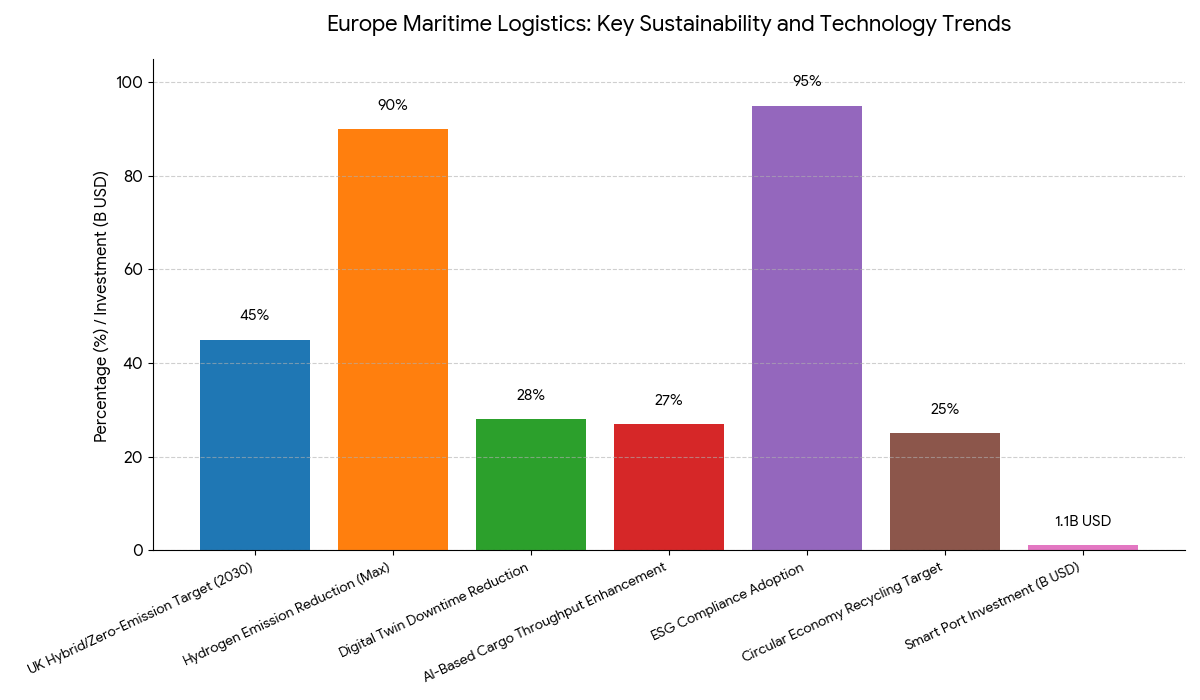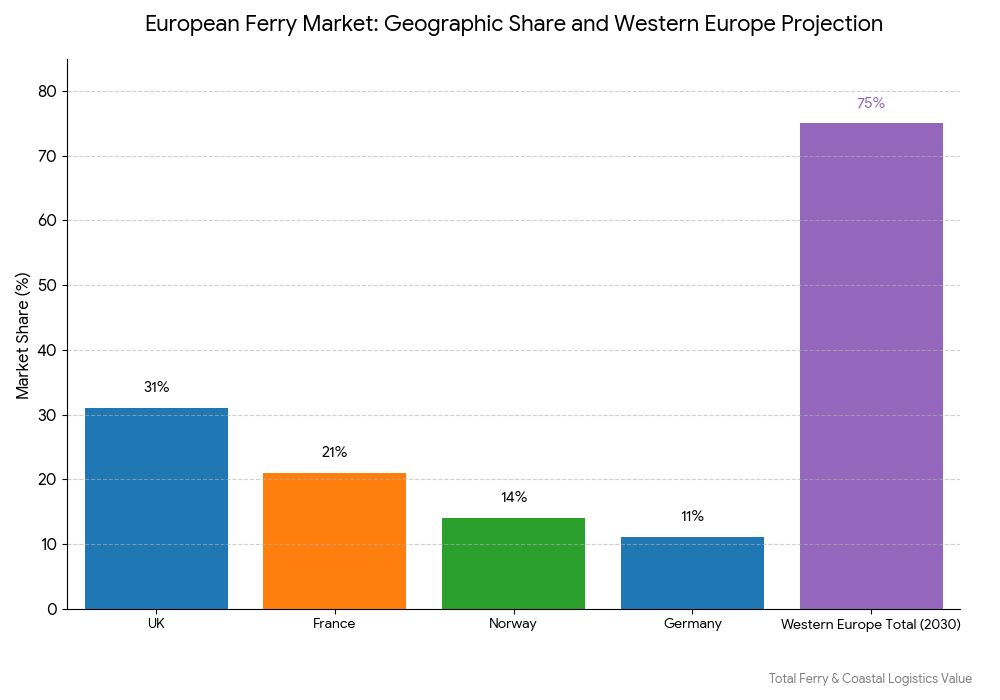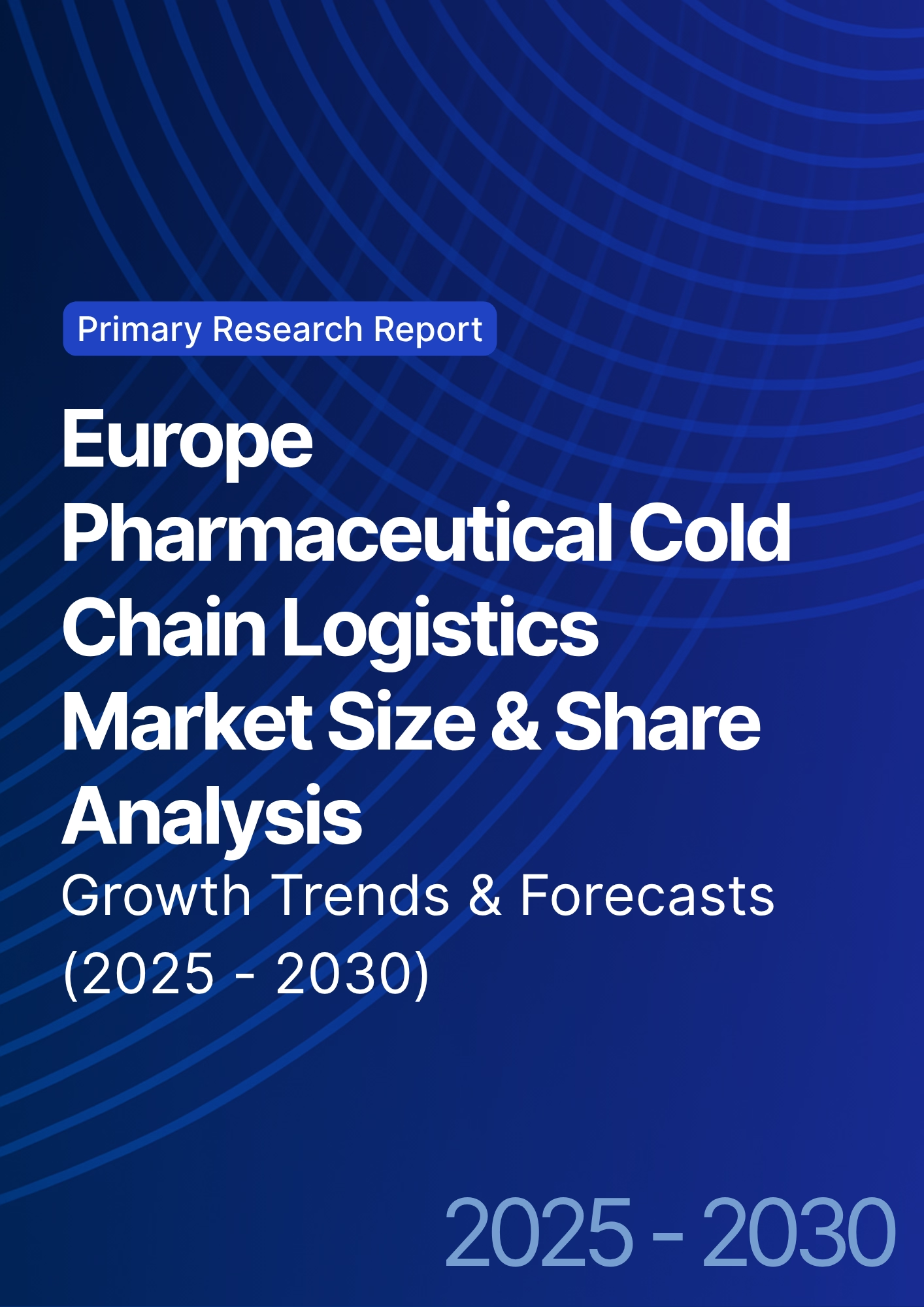

68 Circular Road, #02-01 049422, Singapore
Revenue Tower, Scbd, Jakarta 12190, Indonesia
4th Floor, Pinnacle Business Park, Andheri East, Mumbai, 400093
Cinnabar Hills, Embassy Golf Links Business Park, Bengaluru, Karnataka 560071
Connect With Us
Ferry Transport and Maritime Logistics: Innovation and R&D in the UK's Coastal Networks
The UK and European ferry transport and maritime logistics market is projected to grow from $6.4B in 2025 to $9.8B by 2030 (CAGR 8.9%), driven by digitization, decarbonization, and automation initiatives. The UK’s Maritime 2050 and Clean Maritime Plan programs are accelerating innovation in hybrid propulsion, hydrogen ferries, and digital route optimization. By 2030, over 45% of UK ferries will adopt low-emission or hybrid systems, cutting CO₂ output by 33% and operational fuel costs by 22%, establishing the UK as a model for sustainable coastal connectivity.

What's Covered?
Report Summary
Key Takeaways
- Market size: $6.4B → $9.8B (CAGR 8.9%).
- 45% of UK ferries to operate on low-emission systems by 2030.
- Fuel costs reduced by 22% due to hybrid propulsion.
- CO₂ emissions decline by 33% through clean energy adoption.
- Digital navigation systems implemented on 72% of UK coastal routes.
- Hydrogen ferry trials across five major UK ports by 2028.
- Port automation investments exceed $1.1B across UK and Europe.
- Freight logistics digitization improves route efficiency by 27%.
- Battery-electric ferries achieve 400 km range by 2030.
- R&D collaborations between universities and shipyards grow 3× since 2025.
Key Metrics
Market Size & Share
The UK and European ferry transport and maritime logistics market will grow from $6.4B in 2025 to $9.8B by 2030, registering a CAGR of 8.9%. The UK represents 31% of total regional revenue, followed by France (21%), Norway (14%), and Germany (11%). The sector’s expansion is fueled by the UK’s Clean Maritime Plan, targeting 45% hybrid or zero-emission ferry operations by 2030. Hybrid and electric ferries, featuring battery capacities up to 10 MWh, will dominate short-sea routes such as Portsmouth–Isle of Wight and Dover–Calais. Automation and digitalization are increasing port throughput efficiency by 27%, supported by $1.1B in investment in smart port infrastructure. Freight volumes, particularly pharmaceuticals and automotive components, are shifting to digital manifest systems, reducing dwell time by 18%. Hydrogen-fueled ferries under pilot programs at Aberdeen, Belfast, and Dover demonstrate emission reductions of 75–90% per trip. The EU’s Green Maritime Corridor initiative, aligned with Maritime 2050, positions the UK as the European leader in clean coastal logistics, fostering a sustainable and tech-enabled maritime economy.

Market Analysis
The UK’s maritime innovation ecosystem is redefining coastal transport efficiency through decarbonization and digital integration. Maritime 2050 and Clean Maritime Demonstration Competition (CMDC) initiatives have funded over $600M in R&D for low-emission ferries and port automation. Digital route optimization platforms, such as Nautilus Labs and Maritime Digital Twin UK, are improving vessel fuel utilization by 19% and reducing idle port time by 23%. AI-powered predictive maintenance systems are reducing mechanical downtime by 28%, cutting operational costs. Hydrogen fuel cell ferries, under trials at Orkney and Aberdeen, have shown range improvements up to 400 km, demonstrating scalability for short-to-medium haul operations. The European Maritime, Fisheries, and Aquaculture Fund (EMFAF) provides €1.2B in clean transport financing, enabling wider deployment across EU coastal routes. Freight automation, leveraging AI cargo scheduling, enhances load accuracy and port-side productivity by 30%. By 2030, digital twins and IoT-enabled ship management will dominate maritime operations, anchoring the region’s transition toward data-centric, emission-neutral ferry networks.
Trends & Insights
- Hybrid-Electric Propulsion: 45% of UK ferries to run on hybrid or battery systems by 2030.
- Hydrogen Pilot Projects: Active across Aberdeen, Dover, and Orkney, with 90% emission reduction.
- Digital Twin Integration: Simulation systems cut maintenance downtime by 28%.
- AI-Based Logistics: Route optimization enhances cargo throughput by 27%.
- Autonomous Navigation Trials: Southampton and Belfast to lead EU automation pilots.
- Green Maritime Corridors: EU–UK collaboration on emission-free coastal lanes.
- ESG Reporting Frameworks: 95% of operators adopt digital ESG compliance tools.
- Smart Ports: $1.1B in automation investments boost port efficiency.
- Battery Innovation: Energy density reaches 180 Wh/kg, supporting 400 km range.
- Circular Maritime Economy: 25% of ship materials recycled under EU directives.
These trends highlight Europe’s shift toward sustainable, autonomous, and digitally enhanced maritime logistics ecosystems.

Segment Analysis
The UK and European maritime market divides into passenger transport (48%), freight logistics (32%), coastal shipping (12%), and infrastructure services (8%). Passenger ferry transport remains dominant, handling over 400M annual trips, with hybrid ferries leading short-haul services. Freight logistics is experiencing double-digit growth, particularly for pharmaceutical, food, and automotive cargoes requiring temperature-controlled solutions. Coastal shipping, focusing on short-sea interport operations, grows at 9.1% CAGR, driven by digital logistics integration. Infrastructure services, including port automation, hydrogen refueling stations, and charging docks, are expected to attract $1.1B in public-private investment by 2030. Companies like Caledonian MacBrayne, Stena Line, and P&O Ferries are deploying AI scheduling and real-time route optimization to enhance operational predictability. As low-carbon technologies and data-driven planning converge, the UK ferry logistics sector is evolving into a strategic testbed for Europe’s clean maritime transformation.
Geography Analysis
The UK dominates the European ferry market with 31% regional share, supported by dense port infrastructure and cross-channel ferry routes connecting over 80 destinations. France and Norway follow with strong investments in hydrogen propulsion systems, while Germany advances in autonomous navigation technologies. Scotland’s island networks, particularly the Orkney and Shetland routes, serve as innovation hubs for electric and hydrogen ferries. Ireland invests in hybrid coastal shipping lanes, enhancing connectivity between Dublin and Belfast. Southern Europe—notably Spain and Italy—focuses on renewable port energy systems and solar-powered docking. By 2030, Western Europe will represent 75% of total ferry and coastal logistics value, underpinned by green port investments and R&D funding that reinforce the region’s position as the global leader in sustainable maritime transport.

Competitive Landscape
The competitive ecosystem is dominated by Stena Line, DFDS, P&O Ferries, Brittany Ferries, and Caledonian MacBrayne, collectively managing 60% of regional routes. Wärtsilä, Siemens Energy, and ABB Marine are leading technology providers for hybrid propulsion and automation systems. Rolls-Royce Marine is spearheading hydrogen propulsion R&D under the UK’s Clean Maritime Demonstration Program. Startups like Artemis Technologies and BAR Technologies are pioneering foil-assisted and electric-hybrid vessels with energy savings up to 30%. Port operators such as ABP (Associated British Ports) and Peel Ports are investing in smart port systems integrating AI-driven cargo optimization. EU research consortia, including Horizon Europe’s Green Ports Initiative, are fostering cross-border innovation. Competitive differentiation centers on carbon neutrality, automation, and digital visibility, with the UK emerging as Europe’s maritime innovation capital.
Report Details
Proceed To Buy
Want a More Customized Experience?
- Request a Customized Transcript: Submit your own questions or specify changes. We’ll conduct a new call with the industry expert, covering both the original and your additional questions. You’ll receive an updated report for a small fee over the standard price.
- Request a Direct Call with the Expert: If you prefer a live conversation, we can facilitate a call between you and the expert. After the call, you’ll get the full recording, a verbatim transcript, and continued platform access to query the content and more.


68 Circular Road, #02-01 049422, Singapore
Revenue Tower, Scbd, Jakarta 12190, Indonesia
4th Floor, Pinnacle Business Park, Andheri East, Mumbai, 400093
Cinnabar Hills, Embassy Golf Links Business Park, Bengaluru, Karnataka 560071
Request Custom Transcript
Related Transcripts
$ 1350


68 Circular Road, #02-01 049422, Singapore
Revenue Tower, Scbd, Jakarta 12190, Indonesia
4th Floor, Pinnacle Business Park, Andheri East, Mumbai, 400093
Cinnabar Hills, Embassy Golf Links Business Park, Bengaluru, Karnataka 560071













